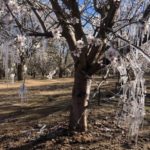Field note written by Allen Vizcarra, Staff Researcher for UC Cooperative Extension, Merced County
Almond frost damage begins when temperatures in orchards drop below approximately 28 °F, but the exact temperature depends on variety. There are a few but important practices to mitigate frost damage in orchards. Common practices include running irrigation water, mowing vegetation, and increasing air flow to the orchard (e.g., using fans to mix cold and warmer air). Implementing any or all these strategies could be just enough to increase the temperature by 1 or 2 °F, which can be enough to avoid or mitigate frost damage.

Almond sensitivity to cold temperatures progressively increases from buds to small nuts, emphasizing the concern for cold temperatures during and after bloom. This past year, we observed survivability of almonds within orchards that were colder than the critical temperatures. This could be due to an increase in flower set of the remaining flower buds that opened after the freeze event. It could also be due to improper estimation of the cold temperature thresholds that we use as guidance. Finally, and more than likely, the varieties commonly planted within the field may be more tolerant to cold temperatures than we thought. Many of these were not ever evaluated for cold sensitivity.
A recent observation near Chowchilla, CA in an orchard using micro sprinklers was the formation of icicles hanging from the lower canopy. There are always questions regarding if this is good or bad. The answer is a “it depends,” but generally it is better for the flowers in the upper canopy than the ones that are covered in ice.
The icicles formed when irrigation water hit parts of the canopy by either unleveled sprinkler (i.e., spray not orientated perpendicular to the ground) or from a high angled spray pattern. Water freezing produces an exothermic reaction, meaning that latent heat is given off from the freezing water which causes a slight warming of buds, flowers, branches, and the surrounding canopy. This exothermic reaction can initially mitigate frost damage for the crop in the lower and upper canopy. However, damage may occur to the iced over flowers when the ice thaws and causes an endothermic reaction where heat is being conducted out of the frozen buds, flowers, and branches. The damage from this endothermic reaction may not have as great of an effect in the surrounding canopy as long as the air temperature is warm enough to offset the localized cooling effect. With that stated, it is more common to see these iced over flowers fail to set.
Although the frost risk for 2018 is over, keep in mind the lessons that we learned this past year. Make sure the pump and irrigation systems are ready to go as bloom 2019 approaches. When designing a system in frost prone areas, make sure there are high enough flows to provide warming. Finally, pay attention to the weather. Frost events can be complex and difficult to predict as they are heavily influenced by humidity and pressure at specific temperatures. Weather services can aid in giving you a short notice advisory for oncoming events.
The Almond Doctor Field Note is a series of posts that will cover observations made from the field by staff research assistants of the University of California Cooperative Extension office of Merced County. While Field Note posts may reference completed or on-going research, its intent is to share notable observations from the field, not to summarize research findings or describe current recommended farming practices.


Rick Cosyns
May 2, 2018Thank You for the insightful article on the 2018 Almond Frost Event. I farm almonds in the Chowchilla and Madera area, while we saw temps in the mid 20’s the crop looks remarkably good. Non Pareil took a hit but still maintain a harvestable crop. Orchard floors were clean and we used every trick in our arsenal. A gut wrenching learning experience I hope not to see again in the distant future! Keep up the good work.
David Doll
May 8, 2018Thanks Ryan. I am glad that you had some crop that made it through the event. Good luck with the rest of the season.
David
Mahesh Karoshi
February 16, 2022Next Wednesday the temperature is dropping to 28F, Which temperature we should look into? There is a Temperature column and Feels like temperature column. Which temperature we should look into? Actual temperature is 32F, feels like temperature is 28F.